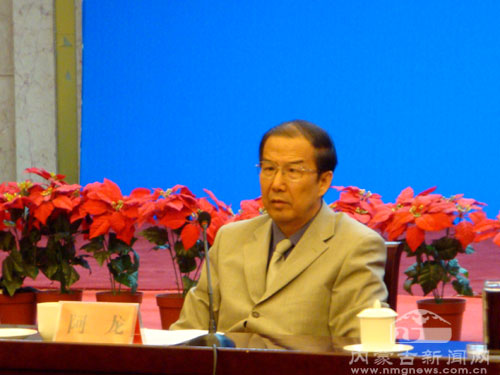 |
|
|
A-Long, Deputy Director
of Party Committee
Propaganda Department of
Inner Mongolia
Autonomous Region
|
The following is a report by the China News Service, one of China's official news agencies, citing Chinese officials denouncing foreign news media for criticizing China's "Ecological Migration" Project that has been aiming at a complete relocation of Mongolian herders from their grazing lands to agricultural and urban areas. The original report in Chinese appeared on the China News Service (Zhong Xin She) website on July 15, 2010. The English translation is by SMHRIC.
In response to Western news media’s criticism over the displacement of Inner Mongolian herders, A-long, Deputy Director of the Inner Mongolia Autonomous Region Party Committee Propaganda Department told reporters that the implementation of the Ecological Migration Project is consistent with the fundamental interests of the people of the Autonomous Region and of the people of China. He went on to protest the criticisms of the Western media.
It has been reported that 450,000 herders and farmers at a cost of 2 billion Yuan have been relocated to prevent the grassland ecosystem from continuing degradation, since the Western Development initiative.
Recently at a press conference on Inner Mongolian ecological development issues, A-long stated that in recent years Western news media have criticized the Autonomous Region’s relocation projects on numerous occasions, claiming that relocation is causing the gradual extinction of Mongolian culture and worsening the herders’ living conditions following relocation.
A-long pointed out that if the Autonomous Region’s ecosystem is left to rampant destruction, it will impact the whole world. Sandstorms caused by the degradation of Inner Mongolian grassland ecosystem not only threaten the livelihood of the people of China but also affect Korea and Japan.
Ji Dacai, Deputy Director of the Autonomous Region’s Department of Agriculture pointed out at the meeting that the selection criteria of areas where relocation is deemed necessary is very strict. Selected areas should be places where the basic condition of production and livelihood is not satisfied, where grasslands have already turned to deserts and herders’ livestock have died in large numbers preventing herders and farmers to continue to maintain their livelihood.
In regards to resettling the relocated herders and farmers, Ji Dacai said that there are two approaches: 1. relocate herders and farmers to places where water resources are relatively rich, where herders can raise their livestock within fenced areas; 2. transfer herders and farmers to urban areas where elders will be given a basic pension and younger individuals will be given training in skills required for secondary and tertiary industrial production.
Ji Dacai said the relocation work in pastoral areas is extremely complicated. Due to a language barrier and the limitations of long maintained traditional production mode and life style, herders are facing difficulties in employment once relocated to urban areas.
A-long explained that herders and farmers can enjoy housing and subsidies like pension after relocation; various areas came up with policies offering education free of charge for ethnic minorities, under which ethnic minorities can enjoy an education free of charge for 5 to 9 years accordingly. He also admitted that the Ecological Migration Project has some short-term impacts on herders’ life.
Aiming at the “Ecological Compensation Regulations” that are about to be passed, Ji Dacai said, [he] has already recommended to the National Development and Reform Commission that the compensation should guarantee the herders’ living standard to be no lower than that of the local population. This is in consideration of the production loss to herders caused by the livestock reduction, livestock grazing ban, and livestock grazing suspension etc.
On July 8, at the Western Development Press Conference organized by the State Council’s Information Office, Inner Mongolian officials stated that the fragile state of the Inner Mongolian ecosystem has not fundamentally improved yet; In the future, an ecological compensation mechanism should be developed to speed up the livestock grazing ban, livestock grazing suspension, demarcation based rotational livestock grazing, and to increase the scale of compensation and extend the subsidy term to those herders and farmers in the areas where the project is implemented.
Reportedly, neighboring with China’s North, North East and North West, the Inner Mongolian grasslands have been a place where the northern ethnic minorities such as the Mongolians have lived and thrived there for generations. Thanks to the grassland’s capability to preserve soil and water and prevent lands from desertification, the Inner Mongolian grassland ecosystem plays an irreplaceable role in maintaining the stability of the ecosystem of China’s Three Northern Areas.







